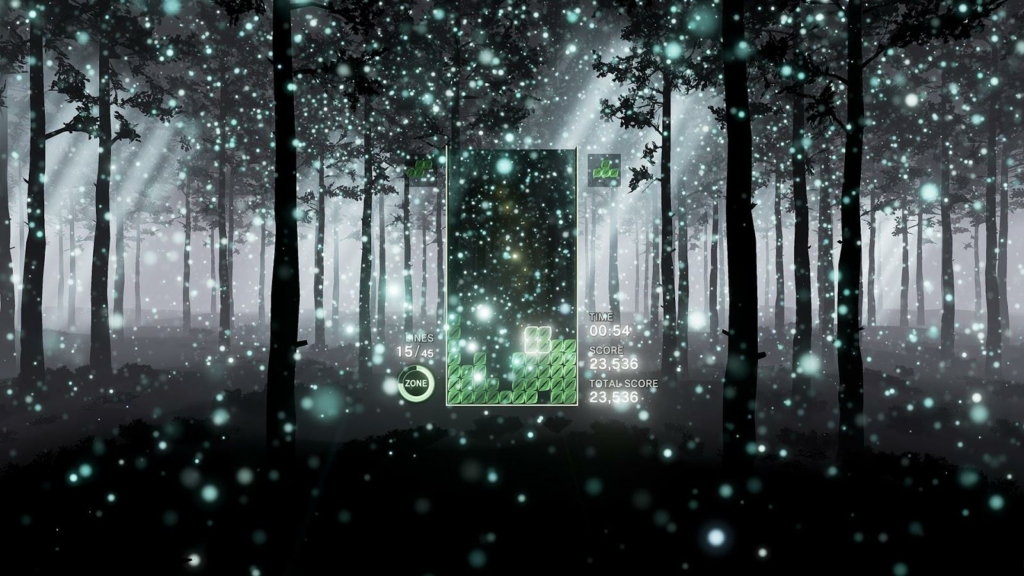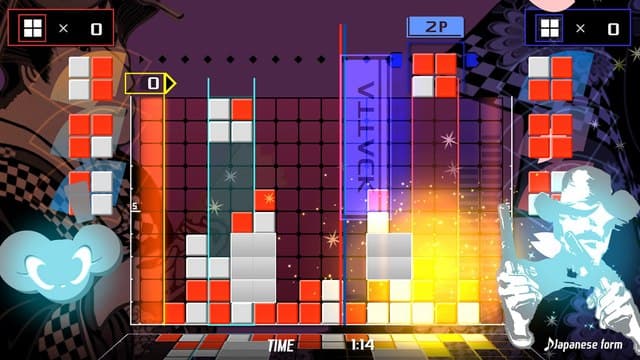Earlier this year I visited Disneyland Paris. In the snowy evening of my first night, I stood in the courtyard in front of Sleeping Beauty Castle to catch the ‘Disney Illuminations’ show: a combined ceremony of light projection, fireworks, and music, casting iconic scenes from Disney’s storied movie history onto the famous structure.
I adored these animations as a child, but hadn’t really revisited in recent years. Then, in my early 20’s, I was shocked at how it overwhelmed me with emotion. Out of nowhere, a wave of joy came over me. I could feel tears in my eyes at the pure association of this visual display.
Light, color, sound, and memory came together to create a beautiful moment—one I’ll likely never forget. I thought I’d never feel anything similar so soon again, or perhaps in my entire life. But then, just last week, I strapped on a big plastic headset and played Tetris Effect.

Synesthesia Symphony
Tetris Effect is a game by Tetsuya Mizuguchi, famous for working on games like Lumines, Space Channel 5, and Rez. I have played none of the above, which made this experience even more visceral than I anticipated. His games turn you into a living instrument and are often developed with the core goal of creating the incredible sensation of synesthesia: triggering one sense by stimulating another. If you’ve ever associated a specific color with a specific number, you have the idea.
That’s why Mizuguchi’s games are so revered among fans of artistic games. They’re truly unlike anything else, especially for synesthetes.
Mizuguchi has wanted to work on a Tetris game for a while now and this is the culmination of his passionate efforts. It may feel strange—even instinctively abrasive—to hear that a Tetris title is one of 2018’s best games. There have been some massive, incredible blockbusters this year to give it some high-profile competition. What on earth could reinvent and iterate Tetris so much, some 34 years after its release? Well, the answer starts and stops with Journey Mode.
Billed as an exploration “from the depths of your soul to the outer reaches of the galaxy,” the campaign mode is the main event of Tetris Effect. It’s a series of levels that chart the history of humanity from humble sea life to a space-exploring civilization and everything in between. It is a celebration of our greatest achievements through the power of music.

The Movement of Music
Both in virtual reality, and on a standard screen, the game faces you with a standard Tetris board in the center of space. Figments of light and color swirl around you, attuned to the theme of a particular symphony. Rotating a tetromino acts as the harmony. Each button press results in a note that complements the established backbeat perfectly.
Forming and clearing a line is, therefore, a crescendo. It creates a pulsating injection of adrenaline that sends an immediate rush of endorphins to your brain. In turn, it develops the song. The backdrop will change as you advance through each level, with the stage-specific song building or receding in tempo as you play. As the song progresses, the classic tetrominoes fall faster—as tetrominoes usually do.
Songs are arranged into sets; usually a series of four slightly connected “missions” grounded with a common theme. The inspired design behind these individual levels is utterly fascinating. A moody, agoraphobia-inducing forest glade comes to life to the tune of dewdrops, with beams of daybreak tied to every drum beat. A blood-pumping tribal cacophony beats at the foot of a volcano.

Desert of Dreams
Although my personal favorite is a dreamlike vision of the evolution of civilization. It starts in the humble desert and ends on the surface of the moon. The twinkling notes of a piano serenade your soul as the narrative of this four-minute piece builds to a star-crossed crescendo.
I first played the set, “Deserted,” late at night in a darkened room, with little to no distractions. My virtual reality goggles steamed up with tears when the “message” of the level revealed itself to me. This was totally involuntary. The beauty is that Tetris Effect doesn’t really try to make you cry for the sake of it. The power of this emotional experience is in how much you give yourself over to it, and the connections you form in your brain between the audio and visuals.
From the vibrations you feel in your hands as you line up blocks, to the warmth the visual stimuli create in your heart, each unfolding story feels absolutely revolutionary. More than that, it’s a totally natural fit for the medium. It’s all about juxtaposition and space—the presentation of two separate ideas and the distance between them that results in one overwhelming feeling.

Let the Blocks Wash Over You
I can’t really compare Tetris Effect to another game. Possibly because I’ve never played Mizuguchi’s work before. But besides my opening anecdote, I can compare it to some musicians I enjoy. The electronic artist Porter Robinson, and their frequent collaborator Madeon, spring to mind.
Robinson’s album “Worlds” is the main point of comparison. It also crafts entire landscapes in your brain purely through the power of song. Yet, in Tetris Effect, you actually get to create the music yourself through gameplay. It’s utter genius. Besides a few that rely on music alone, like the aforementioned “Deserted,” my favorite tracks are the ones that involve a vocal performance. The angelic siren songs found in levels like “Metamorphosis,” “Mermaid Cove,” and “The Deep” are immensely moving. It usually takes a mere line, regardless of the lyric, to send a wave of powerful frisson through my body.
In the more relaxed, often underwater explorations I found myself sighing deeply, reclining, and living in the moment as all of the stress left my shoulders after a hard day. I’ll definitely return to Tetris Effect to play some of its most therapeutic levels when I need to chill out.

Going on a Journey
Unfortunately, while Journey Mode is a masterwork in its own right, it eventually ends. You unlock a compelling “Theater Mode,” which strips away the gameplay and lets you control the visuals. But there’s not technically much to do besides play Tetris.
That being said, it’s Tetris. The game inherently holds a lot of replay value, especially if you’re a score geek. Although you may get a bit frustrated at The Journey’s sudden difficulty spikes (if, like me, you’re not actually great at Tetris).
I’ve not played a Tetris game properly since the Game Boy Color version in the late 90s. So I completed the campaign on “Beginner” difficulty. Don’t let that make you think it was easy. The final mission throws this incredible difficulty spike at you, which unfortunately reveals what I think is one of the game’s few problems: the gameplay sometimes interferes with “the experience.”

Harder Than Harmony
The final level should have been a relaxing, emotional odyssey, like its predecessors. It actually felt like slamming my head against a brick wall. Instead of the usual 30 lines to clear (on Beginner), you need to clear 90. Meanwhile, the tetromino speed ramps up to a stressful seven.
It was nothing like anything I’d experienced prior. I had to research Tetris tactics and repeatedly practice to get it done. I eventually employed the “well” technique and thought hard about my placement instead of just enjoying the experience.
But I didn’t want to. It kind of marred the whole, otherwise relaxing thing for me. Tetris Effect becomes more of a game than an experience at that point. I even opted to take off my immersive VR headset to concentrate. I’m pretty sure that’s not what the developers wanted.

Making Your Way in the World
These spikes aren’t common across the lighter levels, but you can certainly get distracted by the intricacies of block rotation when the environment should be making your brain drift into bliss. This is especially prevalent when the difficulty sucker punches you.
In discussing this with a friend, they joked that it could be “a metaphor for life”—that you often can’t focus on the beauty of living because you’re too busy trying to survive. Despite their intention, I think that’s a compelling answer. If that was the point… well played to the developers. Tetris Effect may be way more existential than I first thought. That the game even inspired this line of questioning is worthy of merit.
Outside of the Journey, there are multiple “Effect Modes” to tinker with: like an ridiculously fast “Master” mode for masochists, and one that throws out mystery effects to test your adaptability. There’s really something for everyone in this section. Personally, I prefer the “Relax’” modes that let you chill out to a curated playlist of levels without any “Game Overs.” I truly endorse drifting into the ether of sound and color.
There’s no proper multiplayer, which is a shame. There have been some really astounding competitive Tetris modes over the years. Although there is a sort of cooperative component. Players can contribute to a weekly score that temporarily unlocks a retro stage. It’s cool!

Future Forward
Still, I’d like to see further collaborations with various electronic artists. It could result in some fascinating experiences that push Tetris Effect further. There’s more room to grow, but it does feel a bit bare bones for the price. Even though the baked-in content is great.
PSVR has long been a machine laden with gimmicky, three-hour “experiences.” And most of those are only fun for about 30 minutes. This is the first “experience” to get a genuine emotional response out of me. It proves there is something to be said for the power of this platform.
Astro Bot: Rescue Mission might be the killer app that proves VR gaming is worthwhile, but Tetris Effect is the artistic dam buster that will hopefully bring auteurs into virtual reality development. I’m sure this will inspire future games of this nature that attack the core of the human experience to deliver essential, almost hallucinatory VR adventures into the depths of the soul.


